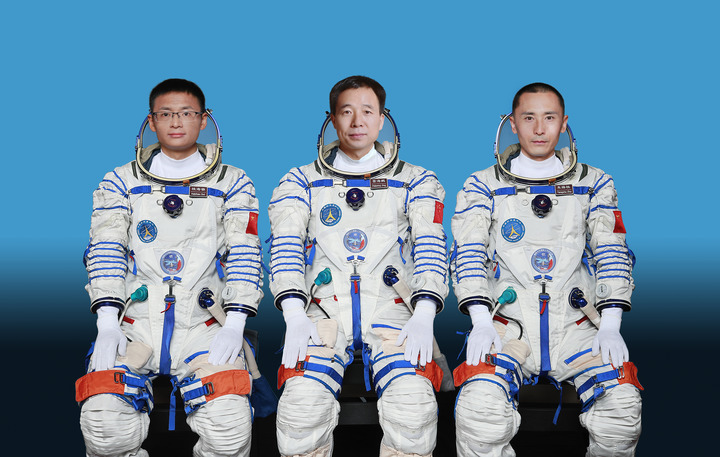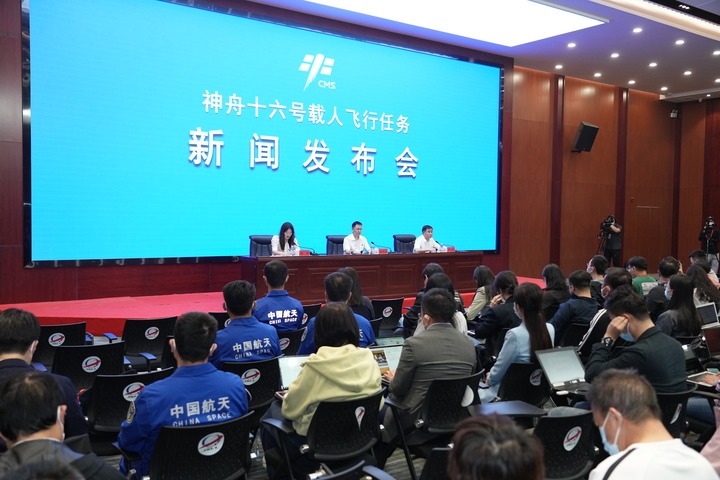 Bridging News
Bridging News
China to Launch Shenzhou-16 Crewed Spaceship on May 30
Jiuquan - The Shenzhou-16 crewed spaceship is scheduled to be launched at 9:31 a.m. Tuesday (Beijing Time) from the Jiuquan Satellite Launch Center in northwest China, announced the China Manned Space Agency (CMSA) on Monday.
The spaceship will carry three astronauts -- Jing Haipeng, Zhu Yangzhu and Gui Haichao -- to carry out the Shenzhou-16 spaceflight mission. Jing will be the commander, said Lin Xiqiang, deputy director of the CMSA, at a press conference.
Shenzhou-16 is the second flight mission of China's manned space program this year, and the first crewed mission after China's space station entered the application and development stage.
The launch will use a Long March-2F carrier rocket, which will be filled with propellant soon, Lin said.
After entering orbit, the spaceship will perform a fast automated rendezvous and docking with the radial port of the space station core module Tianhe, forming a combination with three modules and three spacecraft, Lin said.
The Shenzhou-16 crew will stay in orbit for about five months, and will return to the Dongfeng landing site in north China's Inner Mongolia Autonomous Region in November this year.
During their stay, they will witness the arrival of the Shenzhou-17 crewed spaceship, he said.
The space station combination is now in a stable status with all equipment functioning well. Product qualities of the Shenzhou-16 spaceship and the Long March-2F carrier rocket are under control, Lin said.
The Shenzhou-16 crew is in good condition, while the ground system facilities are in stable operation, Lin said.
All preparations for the launch have been completed, he added.
---
China unveils Shenzhou-16 crew, with diverse types of taikonauts to space station

This undated photo shows Chinese taikonauts Jing Haipeng (C), Zhu Yangzhu (R) and Gui Haichao who will carry out the Shenzhou-16 spaceflight mission. (Photo/Xinhua)
Jiuquan - Chinese taikonauts Jing Haipeng, Zhu Yangzhu, and Gui Haichao will carry out the Shenzhou-16 spaceflight mission, and Jing will be the commander, the China Manned Space Agency (CMSA) announced at a press conference on Monday.
Jing, a senior spacecraft pilot, will become the country's first taikonaut to go into space for the fourth time. He was involved in the Shenzhou-7 mission in 2008 and commanded the Shenzhou-9 and Shenzhou-11 crews in 2012 and 2016, respectively.
Zhu and Gui are set to embark on their first trip to space. Born in 1986, they are members of China's third batch of taikonauts, whose selection was completed by September 2020.
Zhu will serve as a spaceflight engineer in the Shenzhou-16 mission. He will work with commander Jing to control and manage the spacecraft, and conduct technical tests. Gui, a civilian taikonaut and a spectacled professor at Beijing-based Beihang University, will work as a payload expert responsible for the in-orbit operations of science experiment payloads in China's Tiangong space station.
Compared to previous crews, the Shenzhou-16 comprises a diverse trio of male astronauts from different career backgrounds, including aircraft pilot, flight engineer and payload specialist.
"This is the first crewed mission with the participation of three types of taikonauts," Lin Xiqiang, deputy director of the CMSA, said at the press conference.
Although the fresh crew has a 20-year age gap, the three have worked together very well.
"We have gotten along like a family," said Jing when the trio met the press on Monday.
According to the CMSA, among China's third batch of taikonauts, seven are spacecraft pilots, seven are flight engineers and four are payload experts. After more than two years of rigorous training, they have become capable of performing spaceflight tasks.
"All of them have started targeted training for the space station in the new stage and will become the backbones of the follow-up missions," Lin said, adding that more new members will be selected to be space travelers in the future.
The Shenzhou-16 crewed spaceship will be launched at 9:31 a.m. Tuesday (Beijing Time) from the Jiuquan Satellite Launch Center. It will be the first crew mission after China's space station program entered the stage of application and development.
The three taikonauts will stay in orbit for about five months, Lin said.
---
China discloses tasks of Shenzhou-16 crewed space mission

A press conference is held in Jiuquan Satellite Launch Center in northwest China on May 29, 2023. (Photo/Li Gang, Xinhua)
Jiuquan - The Shenzhou-16 astronauts will conduct large-scale in-orbit tests and experiments in various fields as planned, announced a senior official from the China Manned Space Agency (CMSA) at a press conference on Monday.
They are expected to make high-level scientific achievements in the study of novel quantum phenomena, high-precision space time-frequency systems, the verification of general relativity, and the origin of life, said Lin Xiqiang, deputy director of the CMSA.
The Shenzhou-16 mission will also install electric propulsion cylinders and lift extravehicular cameras, Lin said.
In addition, this mission will complete the installation of large extravehicular application facilities such as radiation biological exposure experiment equipment, he said.
The Shenzhou-16 crew, consisting of Jing Haipeng, Zhu Yangzhu and Gui Haichao, will witness the dockings of the Tianzhou-5 cargo craft and the Shenzhou-17 crewed spaceship, as well as the departures of the Shenzhou-15 manned spaceship and Tianzhou-5, he said.
They will give space lectures during their mission.
China's space station has entered the stage of application and development. Work handovers of different groups of astronauts and cargo supply missions will be implemented regularly in following missions.
According to Lin, the in-orbit work of astronauts mainly covers six categories.
The first is to operate the dockings and returns of crewed spaceships and assist the dockings and departures of cargo craft and survey telescopes, ensuring the regular personnel rotation and material supply.
The second is the maintenance of the space station complex, including the spacecraft status setting, in-orbit material management, platform equipment maintenance and inspection, equipment installation inside and outside the modules, and payload entry into and exit from the modules.
The third is health management of astronauts, including health status monitoring and in-orbit exercise and training.
The fourth is to conduct large-scale in-orbit scientific research and applications.
The fifth is the popularization of science, such as giving space lectures and shooting videos for public service.
The sixth is to handle emergent in-orbit failures, fix and replace faulty equipment, and conduct extravehicular maintenance when necessary, so as to ensure long-term stable operation of the space station.
---
China to realize manned lunar landing by 2030
Jiuquan - China plans to realize manned lunar landing by 2030, announced the China Manned Space Agency (CMSA) at a press conference Monday.
Lin Xiqiang, deputy director of the CMSA, said at the conference that China has recently initiated the lunar landing phase of its manned lunar exploration program.
The overall goal is to achieve China's first manned landing on the moon by 2030 and carry out lunar scientific exploration and related technological experiments, he added.
According to Lin, the goal also includes mastering the key technologies such as Earth-moon manned roundtrip, lunar surface short-term stay, human-robot joint exploration, accomplishing multiple tasks of landing, roving, sampling, researching, returning, and forming an independent capability of manned lunar exploration.
China's manned lunar landing will promote the leapfrog development of manned space technology from near-Earth to deep space, deepen human understanding of the origin and evolution of the moon and the solar system, and contribute Chinese wisdom to the development of lunar science, he said.
The CMSA has carried out various research and development work to achieve the goal on the basis of preliminary key technology research and program demonstration, including the research and development of the new-generation manned launch vehicle Long March-10, new-generation manned spaceship, lunar lander and lunar landing suits, as well as the building and testing of a new launch site, facilities and equipment.
The CMSA will release announcements later to solicit proposals for scientific payloads and manned lunar rover, and for names of new-generation manned spaceship and lunar lander, according to Lin.
---
China's space station looking forward to participation of foreign astronauts
Jiuquan - China is looking forward to and welcomes the participation of foreign astronauts in the country's space station flight missions, said the China Manned Space Agency (CMSA).
Lin Xiqiang, deputy director of the CMSA, made the remarks ahead of the launch of the Shenzhou-16 crewed spaceship, which is scheduled for 9:31 a.m. (Beijing Time) on Tuesday, and will take place at the Jiuquan Satellite Launch Center in northwest China.
During the development and construction of China's space station, the country has carried out various forms of exchanges and cooperation with many foreign space agencies and international organizations.
"On the one hand, China is steadily pushing forward the planned cooperation projects with the United Nations Office for Outer Space Affairs, the European Space Agency and other organizations. On the other hand, China has actively expanded exchanges with emerging space nations, focusing on in-orbit scientific experiments and applications, and joint flights for astronauts to the space station," Lin said.
In addition, China has been actively engaged in discussions and the making of regulations pertaining to issues like space environment governance, space traffic management, and the development and utilization of space resources. These efforts have contributed to addressing common challenges of humankind in outer space, the CMSA spokesperson said.
With a complete near-Earth manned space station, a manned shuttle transportation system, and a comprehensive framework for selecting, training and supporting taikonauts, China is now able to carry out crewed missions on a regular basis with a frequency of twice a year.
---
Shenzhou-15 mission goes smoothly, obtaining valuable experimental data: official
Jiuquan - The Shenzhou-15 crew has successfully completed four extravehicular activities (EVAs), becoming the crew to accomplish the most frequent EVAs of all Chinese crews to date, announced a senior official from the China Manned Space Agency (CMSA) at a press conference on Monday.
The Shenzhou-15 astronauts have been working and living in-orbit for 181 days. All in-orbit work is progressing smoothly, said Lin Xiqiang, deputy director of the CMSA.
They have conducted eight human factors engineering research activities, 28 space medical experiments and 38 space science experiments covering life ecology, material science and fluid mechanics, and obtained valuable experimental data, said Lin.
Currently, they are making preparations for the arrival of the Shenzhou-16 crew and their own return to Earth. Before departure, they will continue some in-orbit space science experiments and conduct a work handover with the Shenzhou-16 astronauts.
Astronauts on long-term missions in orbit usually need about six months to recover after a mission, said Lin, adding that they can transfer to normal work and training and participate in the next round of crew selection if they pass the evaluation.
Once selected, they usually go through about one to one and a half years of training to fly again. "I believe that we will see them again in future flight missions," Lin said.
---
 Related Stories
Related Stories